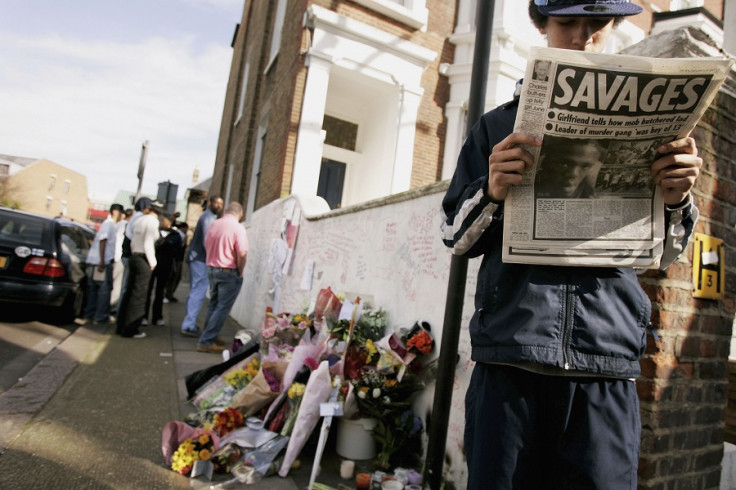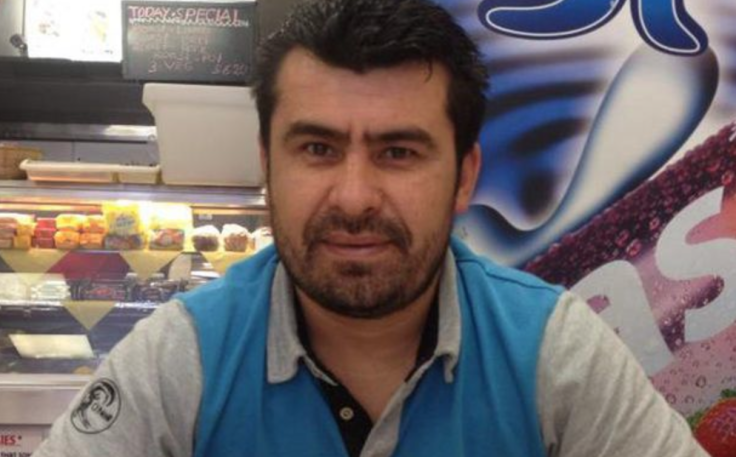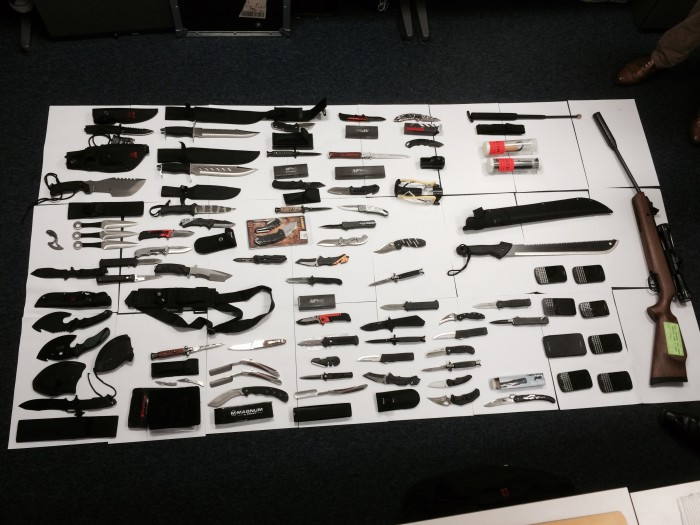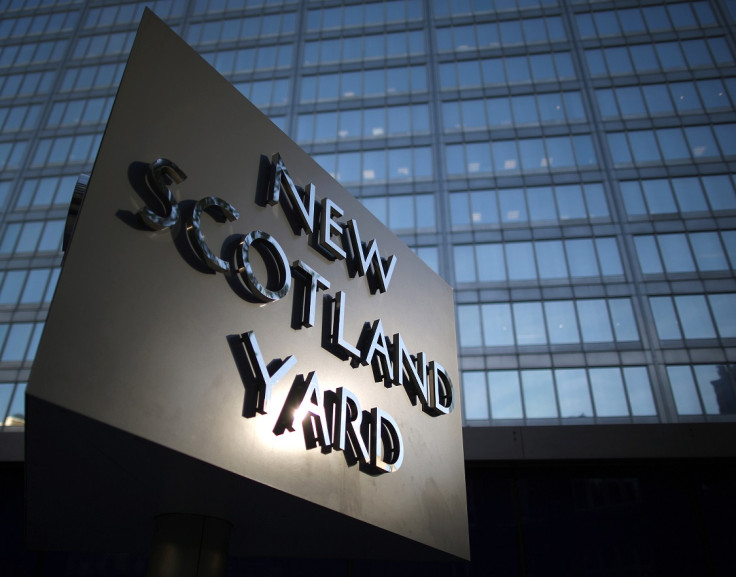Inside Gangland London: 'I used to get a rush kicking in a door or kidnapping someone'

One week after teenager Mohammed Dura-Ray became the latest victim to be killed in a suspected gangland feud, IBTimes UK was given an insight by reformed gang members into what life is like on the road with the London's street gangs.
Curtis is walking towards Farringdon train station when he spots a man near the entrance. His strides lengthen as he makes an impromptu diversion towards him.
Stomping through the rain, he fixes his target with a stare as he unzips his rucksack and pulls out a tightly wrapped parcel. Right next to the man, he hunkers down towards, cocks his right hand inches from the man's head before dispensing his surprise: a homemade sandwich.
"I can't, I'm allergic," the soaking street sleeper says. Curtis stands, scavenges his pockets for change but leaves the man's sopping flat cap empty on the floor as he heads into the station.
The attempted generosity is not what you would expect from a man who used to violently raid peoples' homes for a living in one of North London's biggest gangs. But that is what Curtis used to do. And he enjoyed it.
"We would rob jewellery right off people's necks."
"My favourite was robbery, or as we called them 'moves'," he explains. I used to get a rush kicking a door in or kidnapping someone. We used to take everything. Drugs from other dealers, money, jewellery. We would rob jewellery right off people's necks.
"Our theory was if you leave your window open it's your fault. The best result I know of was when someone found £32,000 in a briefcase at a house he robbed. I sold drugs as well but it boring. They were long hours and you were dealing with d** heads all the time."
Curits, 24, is drinking a beer as he recalls being in a street gang that operated out of the north-west London borough of Brent. He recently left the life to become a charity mentor visiting schools to warn gang members of the life they face on the road. But that came to an end when the charity said he still had gangster-like tendencies and himself needed mentoring.

He is speaks to IBTimes UK on condition of anonymity for fear he could be targeted for perceived "snitching". Our meeting takes place on neutral territory in Farringdon in the City of London, away from the estate he was raised on and the gang leaders he looked up to. Although he is a Londoner, his days being taxied by other gang members means he struggles using public transport and is late when we first meet. He is visibly anxious and his eyes dart about the bar we sit inside.
"Paranoia keeps you alive," he says. "There are people who can't do what we are doing now without looking over their shoulder. "Did he just look at me?" "Who's in that car?"
His reason for breaking a mafiosa-type omerta is to explain the random uprisings in violence across the capital, the blame for which he pins on a new, reckless generation of criminals who are just as likely to reach for a knife as they are to brag about it on social media. He was also influenced to lift the lid on gang life after the brazen killing of Erdogan Guzel and Sonya Genchevan in a Wood Green drive-by shooting in July.
"With the new generation there is a lot of hype. They're aged between 10 and 18 and they don't know what it used to be like. They think they're bad boys – rude boys – they think they're the baddest generation.
"They are supposed to be role models but these days there is no respect."
"They treat it like a video game and don't listen to the 'olders'. I always listened to the olders, these are the people who have done it all 10 times before they have even thought about doing it once. They don't know the generation that paved the way for them. They are supposed to be role models but these days there is no respect. They're reckless.
"A 15-year-old executed a woman on her doorstep with a shotgun for what turned out to be £200. Do you know what he spent the money on? A Dolce & Gabbana hat."
He is referring to Santre Sanchez Gayle, whose blasting of Gulistan Subasi, 26, on her mother's Hackney doorstep with a sawn-off shotgun in 2011 convinced detectives it was the work of a professional hitman. He was 15 years old.

Mitch is a 35-year-old former gang leader who had 15 members working under him. He refutes ever being a "boss" – he feels he was never "superior" to others – but agrees that the rising breed lack the moral code of yesteryear's players.
"The way some of them carry themselves today is disgusting," Mitch says. "There are no pleases and thank yous. We grew up in Sunday school and regardless of the bad things we did, we still had respect.
"Everyone is a shooter (drug dealer).You couldn't do that back in the day. You couldn't be a little mug and try to come out on the road and be a shooter. You had to be someone. Now you've got 12-year-old kids doing that s***.
"We were defending friends, not postcodes. If you're mum falls behind in rent and you have to move, how can you fight for an area you don't own? We used to be north-west – not Church Road, not Stonebridge, not Kensal Green. But it's all changed now."
"Regardless of the bad things we did, we still had respect."
There are thought to be around 200 gangs in London consisting of almost 4,000 members. Long-standing networks like the Tottenham Mandem (TMD) and rivals the Hackney Turks have splintered into smaller factions after emerging out of north London in the 1970s.
Some of the most active gangs on London's streets today, Curtis says, are the New Park gang (who rather inventively are also known as "674" after the buttons for "N", "P", "G" on old Nokia phones) out of Lambeth, the Church Road Soldiers from Brent, Kensal Green and London Fields (Hackney). Then there are mainstays like Peckham's GMG (Guns, Murder, Girls) and the Peckham Boys as well as a group in Lewisham that Curtis says is "like an army".
All of them abide by their own code of conduct and each have rackets turning over hundreds of thousands of pounds a year selling cannabis, cocaine, crack, heroin, through prostitution – "owning brothels brings in big money" – arms dealing and robbery.
Then there are those who also dabble in fraud. In one remarkable account, Curtis claims bank managers have unwittingly employed gang members who have run scams under their noses to divert thousands of pounds into leaders' bank accounts.

One lucrative line of business is robbing other drug dealers. Curtis shows IBTimes UK a video of a drug dealer threatening to kill a rival that robbed him of thousands of pounds as well as his stash of narcotics. The gun he brandishes absorbs most on the tiny iPhone screen.
"Each gang has its different set of rules, its own code of conduct," Curtis explains. "But then each member has his own believes. In each gang there is always at least one person who is the murderous violent one, the one who just likes killing. Always. Then there is the person who is the brains, good with money.
"Every gang has at least one person who is the murderous violent one, the one who just likes killing."
"Some gangs are big on recruitment and have a big man power while others are a crew of about five. Grooming plays a big part in recruitment. They wait outside schools, buy them trainers and things to lure them in. Some of the kids have no chance of avoiding the culture, really."
For the first time, Curtis then raises his voice: "Then there is always one guy who is a sneaky p**** who says he would go to jail for you, then he is f****** your girlfriend. Guys have killed people for their friends but will still do something behind their back."
That culture is blamed for the escalation in knife and gun crime in the past year. Instances of people being injured by knives increased by 22% in the past year and gun discharges were up by 16% in London.

In total, 14 teenagers have been killed in London in the past 12 months, 12 of whom were stabbed. The most recent victim of knife attacks was 16-year-old Mohammed Dura-Ray, also known as Moe, who was knifed to death during a mass brawl at Canterbury Place, in Walworth, south London, on 14 September. Seven males were arrested in connection with the stabbing, five have since been bailed and two 16-year-olds face no further action.
The apparent random stabbing – Dura-Ray's parents believe he could have been the victim of mistaken identity – is in stark contrast to the execution of Cem Duzgan in 2009. The 21-year-old of Islington, north London, was peppered in his head and chest with 11 bullets from just 30cm (1ft) away at the Clapton FC Club, a Turkish social club in Hackney. His death was the culmination of a bloody turf war between the Hackney Turks and the Tottenham Turks.
Curtis, who stabbed a classmate with a knife he kept in his pencil case when he was 13, says outbursts of violence today are mainly tit-for-tat attacks with money having the ultimate say on the weapon of choice.
"Youngsters today will kill you and then Tweet about it or rap about it in a video on YouTube."
"Knives have replaced guns partly because guns in London have become too expensive. Five or six years ago it used to be £600 for a brand new one in the box and wrapped in plastic. Now, brand new a snub 38. [a small revolver] will cost between £1,500 and £2,000. An AK-47 costs £5,000. But prices can vary and depends on your connects. Getting your hands on ammo has become difficult, too. You find yourself asking for shells trying to match them to your gun."
Pride and revenge used to be the arbiter when it came to gang violence and while Curtis says emotion still plays a role, new technology and social media has transformed the perception of street gangs. He plays a YouTube video on his phone that he says shows a south London gang rapping about their crimes behind the legitimacy of a record label bearing their name. At the start of the clip is a disclaimer saying the lyrics are "fictional" but Curtis shakes his head.
Here, he says, are the hallmarks of a gang "flossing" – showing off their wealth – to recruit young kids. There's the Range Rover, the Rolexes, fur coats and twinkling jewellery. "Youngsters will now kill you and then Tweet about it or rap about it in a video on YouTube. It has become fashionable now and is not being taken seriously. They're like: 'Let's do the road 'ting, make money, be bad boys.' But they don't give money to their younger siblings or mum, they just spend it on material things to look like gangsters. They do not know how to be men. The older generation would teach us how to be men, not just gangsters."

Since 1998, the Met Police's Trident Gangs Command has made almost 1,300 arrests, leading to gang members being sentenced to more than 1,134 years in total. It has seized 87 firearms and more than £900,000 in cash. Under Boris Johnson, the mayor's office set up the London Crime Reduction Board's Partnership Anti-Gang's Strategy
"When the olders were in their prime you could not f*** with them otherwise it would be game over. Half of them got away with murder because they knew how to do it. It used to be more serious, more structured. You used to get killed for a reason. Now there are senseless killings, they're not organised.
"Ten years ago someone would get shot and within two or three hours there would be retaliation. Now it takes two to three months. That's partly down to the police coming down [of gangs]. They've done a good job in that sense. The police are much more on it.
"Gang members talk about Trident (the Met Police's anti-gang unit), the National Crime Agency as well as the murder unit, the drug unit and the robbery unit. Members have been changing their numbers twice a week because they think they are being listened in on. They are always thinking about them."
Curtis and Mitch's names have been changed
© Copyright IBTimes 2025. All rights reserved.






















